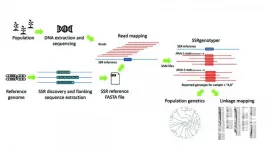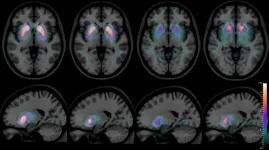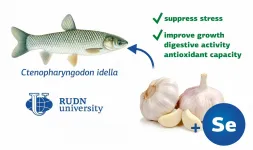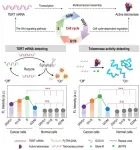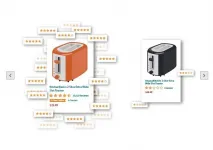(Press-News.org) SSRgenotyper is a newly developed, free bioinformatic tool that allows researchers to digitally genotype sequenced populations using simple sequence repeats (SSRs), a task that previously required time-consuming lab-based methods.
Reporting in a recent issue of Applications in Plant Sciences, the tool's developers designed the program to seamlessly integrate with other applications currently used for the detection and analysis of SSRs.
Simple sequence repeats are short chains of repeating nucleotides that are prone to mutation. The variability of these DNA sequences makes them ideal for genetic analyses to distinguish between individuals and are often the marker of choice for paternity and forensic testing.
In research fields, SSRS have the added benefit of being selectively neutral, meaning they don't code for any physical traits and therefore aren't subject to most types of natural selection, making them an excellent tool to study populations without the obscuring effects of convergent evolution.
Recent advances in next-generation sequencing have helped streamline the process of SSR identification, especially in model organisms or groups with an available reference genome assembly. As technology continues to improve and sequencing costs decrease, sequencing large portions of a genome for the purposes of SSR analysis, even in non-model organisms, is becoming more feasible and widespread in the scientific literature.
However, the process of genotyping -- determining which individuals have which alleles -- still relies predominantly on visualizing amplified DNA on an electrophoresis gel, an involved and potentially hazardous process, as DNA fragments are often stained with carcinogenic chemicals.
It also has the added issue of alleles being measured based on the size of the resulting bands, which is an estimate for the number of nucleotides in the amplified DNA fragment. Because there may be slight variations in the flanking regions that surround the SSRs of interest, and because there is no standardized method of determining an allele's size using these methods, genotyping results from one experiment cannot be easily transferred or compared to those of another experiment.
The development of SSRgenotyper renders such lab-based efforts obsolete. By working in tandem with other bioinformatic programs that detect SSRs in reference DNA and programs that align sequence data from target populations with the corresponding SSR reference file, SSRgenotyper is able to quickly genotype all SSRs for each individually sequenced sample.
"SSRgenotyper goes the next step by genotyping SSRs within sequenced populations -- strictly from sequencing data (no PCR or electrophoresis)," said Jeff Maughan, a professor of Plant and Wildlife Sciences at Brigham Young University and senior author of the study. "The output from SSRgenotyper are files ready for population genetic analysis or linkage map formation."
Not only does the program reduce the amount of time and work required to genotype populations, it also solves the transferability problem inherent in electrophoresis estimates by directly counting the total number of base pairs in a given sequence repeat.
"Since the SSRs are genotyped based on the number of repeated motifs at the SSR locus and not on the PCR product size, the allele calls are standardized and transferable from project to project or from lab to lab," said Maughan.
The program, which is coded in Python 3, requires only three positional arguments to run, provides the option to specify several conditional arguments (such as percentage thresholds for heterozygosity, the size of the flanking regions, and for the removal of spurious alleles), and can be performed on a regular desktop computer.
Once complete, SSRgenotyper generates multiple file types, including basic summary and statistical files, as well as a .pop, a .map, and an alignment file formatted for use in additional programs to facilitate downstream analyses.
As a proof of concept, Maughan and his colleagues tested SSRgenotyper's accuracy at correctly determining an individual's genotype by running the program on publicly available sequences of quinoa (Chenopodium quinoa) and the oat species Avena atlantica. The resulting accuracy rate was 97% or greater, which increased with the inclusion of additional sequence reads.
With the continued development and efficiency of next-generation sequencing methods, tools like SSRgenotyper seem poised to reduce the amount of lab work required in genetic studies.
"Sequencing is already the method of choice in most genetic research projects," said Maughan. "As costs continue to drop and new bioinformatic tools are developed, it is highly likely that future population genetics studies will be based solely on next-generation sequencing -- completely avoiding the cumbersome tasks of PCR and electrophoresis."
INFORMATION:
Citation: Lewis, D. H., D. E. Jarvis, and P. J. Maughan. 2020. SSRgenotyper: A simple sequence repeat genotyping application for whole-genome resequencing and reduced representational sequencing projects. Applications in Plant Sciences 8(12): e11402.
https://doi.org/10.1002/aps3.11402
Applications in Plant Sciences (APPS) is a monthly, peer-reviewed, open access journal focusing on new tools, technologies, and protocols in all areas of the plant sciences. It is published by the Botanical Society of America (http://www.botany.org), a nonprofit membership society with a mission to promote botany, the field of basic science dealing with the study and inquiry into the form, function, development, diversity, reproduction, evolution, and uses of plants and their interactions within the biosphere. APPS is available as part of the Wiley Online Library (https://onlinelibrary.wiley.com/journal/21680450).
For further information, please contact the APPS staff at apps@botany.org.
American actor Robin Williams had a neurodegenerative brain disease called dementia with Lewy bodies (DLB): a distressing disease, with symptoms in common with Alzheimer's disease (AD) and Parkinson's disease (PD). But unlike these two conditions, DLB also entails prominent mood and cognitive swings, sleep disorders, and vivid, sometimes terrifying, visual hallucinations. It is now thought that Robin Williams, whose diagnosis was only ascertained post-mortem, was likely driven to suicide, in 2014, by the terrifying hallucinatory experiences he suffered for years - and about which he never told anyone, not even his wife. Susan Schneider Williams recounted the tragic story in an editorial published in the journal ...
As a new presidential administration takes steps to examine options to control the spread of COVID-19 through increased testing, epidemiologists at The University of Texas at Austin and other institutions have a new analysis that shows the value of having all people in the U.S. tested on a regular, rotating basis to slow the spread of the novel coronavirus and the loss of life from COVID-19. The team's model is outlined in a paper published online today in The Lancet Public Health.
With the introduction of accurate and inexpensive rapid tests, researchers say there is an optimal testing schedule that minimizes costs as well ...
Weekly COVID-19 testing, with two-week isolation of positive cases, is the most cost-effective strategy to mitigate spread of the virus in the USA when transmission is high in affected areas until vaccines are widely available.
When transmission rates are low to moderate, monthly testing and a one-week isolation period is the most cost-effective approach.
Monthly population testing is more cost-effective than the current strategy of testing only people showing symptoms and their close contacts.
Weekly COVID-19 testing, coupled with a two-week isolation period for positive cases, may be the most cost-effective strategy to tackle the ...
A biologist from RUDN University confirmed that selenium nanoparticles and garlic extract can effectively reduce the negative impact of stress on the health of grass carp in the breeding industry. The results of his study were published in the Journal of the World Aquaculture Society.
Grass carp or Ctenopharyngodon Idella is a valuable commercial fish type. In order to increase productivity, fish farms tend to breed more and more fish in small reservoirs. This extreme population density causes stress in carps that negatively affects their health, namely, reduces immunity, slows down growth, suppresses digestion, and interferes with intestinal functions. To mitigate ...
Cancer is a significant cause of death worldwide and many efforts have been devoted to the development of methods for early detection. Telomerase are considered as a tumor biomarker for early diagnosis because the telomerase of more than 80% immortalized cells are reactivated and provides the sustained proliferative capacity of these cells, but the telomerase activity are not detectable in normal somatic cells. Telomerase is a ribonucleoprotein complex that is thought to add telomeric repeats onto the ends of chromosomes during the replicative phase (S ...
DETROIT - Wayne State University School of Medicine researchers have reported that zinc supplements for men and women attempting to conceive either naturally or through assisted reproduction during the COVID-19 pandemic may prevent mitochondrial damage in young egg and sperm cells, as well as enhance immunity against the virus.
In "Potential Role of Zinc in the COVID-19 Disease Process and its Probable Impact on Reproduction," published in Reproductive Sciences, Husam Abu-Soud, Ph.D., associate professor of Obstetrics and Gynecology and the C.S. Mott Center for Growth and Development, ...
Sexual assault and sexual harassment are significant problems in the U.S. military and military service academies in the United States. In 2018, 15.8% of female and 2.4% of male cadets and midshipmen across the military service academies reported unwanted sexual contact in the past year. This unwanted behavior can contribute to a variety of negative mental and behavioral health outcomes.
While the military service academies have implemented multiple sexual assault prevention programs and social marketing campaigns to improve awareness of and response to sexual assault, prevention initiatives have been hindered by an absence of evidence ...
Gun violence among children is lower in states with more gun laws, according to a Rutgers-led study.
The study, published in the Journal of Youth and Adolescence, examined youth gun and weapon carrying data from 2005 and 2017 across several states. Researchers found the rates of youths carrying guns was higher in states and lower in states with more gun laws. According to researchers, this phenomenon could be associated with large urban areas and more significant safety concerns within these areas.
Louisiana and Arkansas reported the highest percentages of youth reporting gun carrying behavior in 2017 and 2013 respectively, with 12.7 percent and 12.5 percent respectively. These two states had 13 gun laws in place while the lowest rates of gun carrying among ...
If you're about to buy something online and its only customer review is negative, you'd probably reconsider the purchase, right? It turns out a product's first review can have an outsized effect on the item's future -- it can even cause the product to fail.
Shoppers, retailers and manufacturers alike feel the effects of customer reviews. Researchers at the University of Florida's Warrington College of Business looked at the influence of the first review after noticing the exact same products getting positive reviews on one retailer's website but negative reviews on others, said Sungsik Park, Ph.D., who studied the phenomenon ...
COLUMBUS, Ohio - Considering the greater good by social distancing during a pandemic turns out to have an attractive personal benefit: A new study has found that staying away from others also reduces an individual person's chances of contracting COVID-19.
Researchers presented study participants with virtual behavior scenarios of various public settings - a grocery store, a crowded beach, a crosswalk - and asked them to place themselves or fictional people in those contexts based on their social distancing preferences.
Four months later, the participants were asked if they had tested positive for SARS-CoV-2 infection or otherwise believed they had been sick with a case of COVID-19.
Statistical analyses ...
